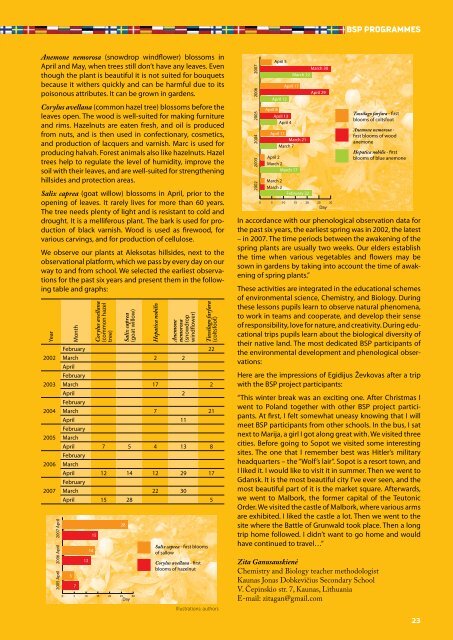newsletter_2008_1.pdf - 5.84 MB - The Baltic Sea Project
newsletter_2008_1.pdf - 5.84 MB - The Baltic Sea Project
newsletter_2008_1.pdf - 5.84 MB - The Baltic Sea Project
Create successful ePaper yourself
Turn your PDF publications into a flip-book with our unique Google optimized e-Paper software.
Anemone nemorosa (snowdrop windflower) blossoms in<br />
April and May, when trees still don’t have any leaves. Even<br />
though the plant is beautiful it is not suited for bouquets<br />
because it withers quickly and can be harmful due to its<br />
poisonous attributes. It can be grown in gardens.<br />
Corylus avellana (common hazel tree) blossoms before the<br />
leaves open. <strong>The</strong> wood is well-suited for making furniture<br />
and rims. Hazelnuts are eaten fresh, and oil is produced<br />
from nuts, and is then used in confectionary, cosmetics,<br />
and production of lacquers and varnish. Marc is used for<br />
producing halvah. Forest animals also like hazelnuts. Hazel<br />
trees help to regulate the level of humidity, improve the<br />
soil with their leaves, and are well-suited for strengthening<br />
hillsides and protection areas.<br />
Salix caprea (goat willow) blossoms in April, prior to the<br />
opening of leaves. It rarely lives for more than 60 years.<br />
<strong>The</strong> tree needs plenty of light and is resistant to cold and<br />
drought. It is a melliferous plant. <strong>The</strong> bark is used for production<br />
of black varnish. Wood is used as firewood, for<br />
various carvings, and for production of cellulose.<br />
We observe our plants at Aleksotas hillsides, next to the<br />
observational platform, which we pass by every day on our<br />
way to and from school. We selected the earliest observations<br />
for the past six years and present them in the following<br />
table and graphs:<br />
Year<br />
2002<br />
2003<br />
2004<br />
2005<br />
2006<br />
2007<br />
2007 April<br />
2005 April 2006 April<br />
Month<br />
Corylus avellana<br />
(common hazel<br />
tree)<br />
Salix caprea<br />
(goat willow)<br />
Hepatica nobilis<br />
Anemone<br />
nemorosa<br />
(snowdrop<br />
windflower)<br />
Tussilago farfara<br />
(coltsfoot)<br />
February 22<br />
March 2 2<br />
April<br />
February<br />
March 17 2<br />
April<br />
February<br />
2<br />
March 7 21<br />
April<br />
February<br />
March<br />
11<br />
April<br />
February<br />
March<br />
7 5 4 13 8<br />
April<br />
February<br />
12 14 12 29 17<br />
March 22 30<br />
April 15 28 5<br />
5<br />
7<br />
12<br />
14<br />
15<br />
28<br />
0 5 10 15 20 25 30<br />
Day<br />
Salix caprea - first blooms<br />
of sallow<br />
Corylus avellana - first<br />
blooms of hazelnut<br />
Illustrations: authors<br />
2005 2006 2007<br />
2004<br />
2003<br />
2002<br />
April 5<br />
April 12<br />
April 17<br />
April 8<br />
April 13<br />
April 4<br />
April 11<br />
March 21<br />
March 7<br />
April 2<br />
March 2<br />
March 17<br />
March 2<br />
March 2<br />
March 30<br />
March 22<br />
February 22<br />
April 29<br />
0 5 10 15 20 25<br />
Day<br />
30<br />
Tussilago farfara - first<br />
blooms of coltsfoot<br />
Anemone nemorosa -<br />
first blooms of wood<br />
anemone<br />
Hepatica nobilis - first<br />
blooms of blue anemone<br />
In accordance with our phenological observation data for<br />
the past six years, the earliest spring was in 2002, the latest<br />
– in 2007. <strong>The</strong> time periods between the awakening of the<br />
spring plants are usually two weeks. Our elders establish<br />
the time when various vegetables and flowers may be<br />
sown in gardens by taking into account the time of awakening<br />
of spring plants.”<br />
<strong>The</strong>se activities are integrated in the educational schemes<br />
of environmental science, Chemistry, and Biology. During<br />
these lessons pupils learn to observe natural phenomena,<br />
to work in teams and cooperate, and develop their sense<br />
of responsibility, love for nature, and creativity. During educational<br />
trips pupils learn about the biological diversity of<br />
their native land. <strong>The</strong> most dedicated BSP participants of<br />
the environmental development and phenological observations:<br />
Here are the impressions of Egidijus Ževkovas after a trip<br />
with the BSP project participants:<br />
“This winter break was an exciting one. After Christmas I<br />
went to Poland together with other BSP project participants.<br />
At first, I felt somewhat uneasy knowing that I will<br />
meet BSP participants from other schools. In the bus, I sat<br />
next to Marija, a girl I got along great with. We visited three<br />
cities. Before going to Sopot we visited some interesting<br />
sites. <strong>The</strong> one that I remember best was Hitler’s military<br />
headquarters – the “Wolf’s lair”. Sopot is a resort town, and<br />
I liked it. I would like to visit it in summer. <strong>The</strong>n we went to<br />
Gdansk. It is the most beautiful city I’ve ever seen, and the<br />
most beautiful part of it is the market square. Afterwards,<br />
we went to Malbork, the former capital of the Teutonic<br />
Order. We visited the castle of Malbork, where various arms<br />
are exhibited. I liked the castle a lot. <strong>The</strong>n we went to the<br />
site where the Battle of Grunwald took place. <strong>The</strong>n a long<br />
trip home followed. I didn’t want to go home and would<br />
have continued to travel…”<br />
Zita Ganusauskienė<br />
Chemistry and Biology teacher methodologist<br />
Kaunas Jonas Dobkevičius Secondary School<br />
V. Čepinskio str. 7, Kaunas, Lithuania<br />
E-mail: zitagan@gmail.com<br />
BsP PROGRAMMEs<br />
23





